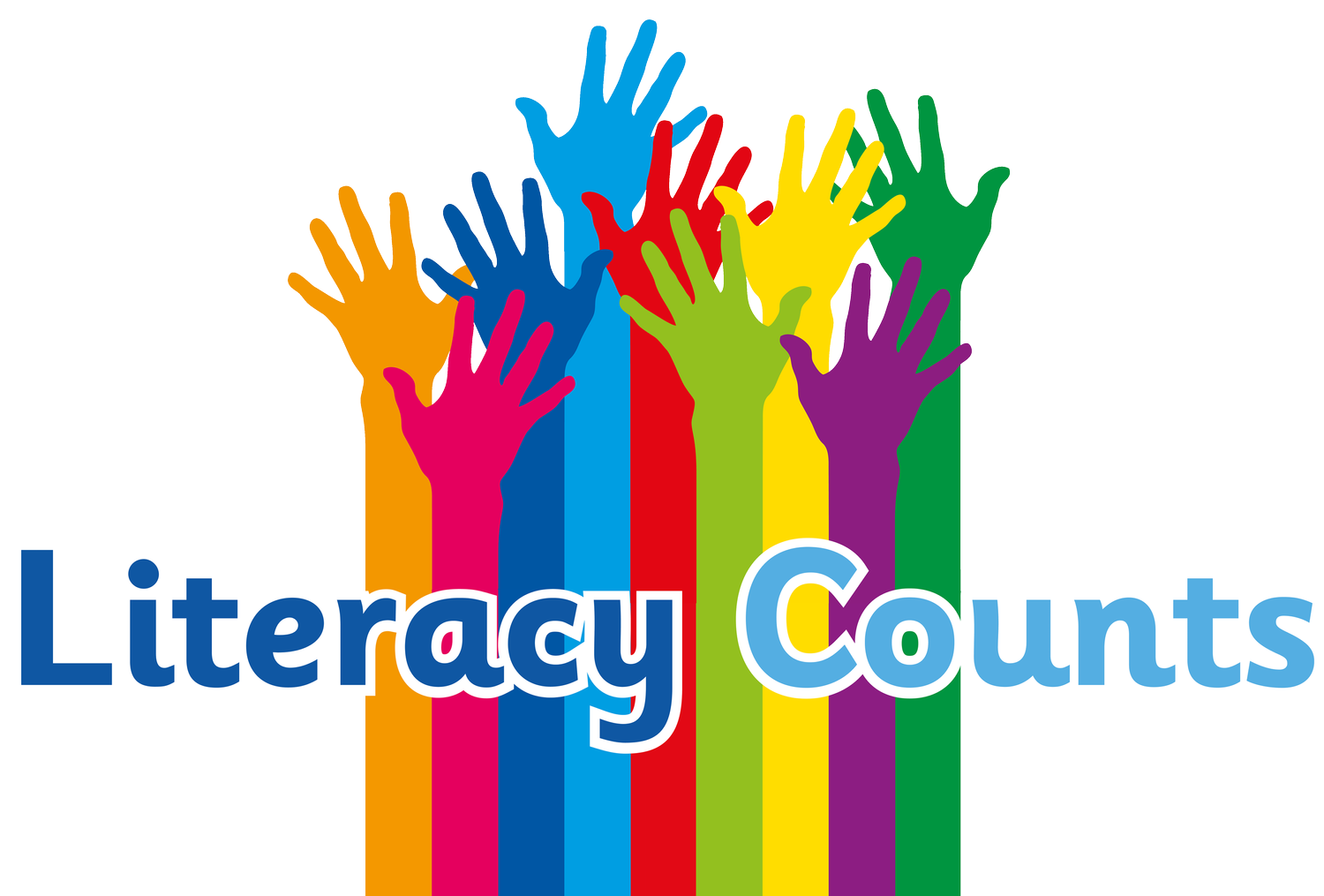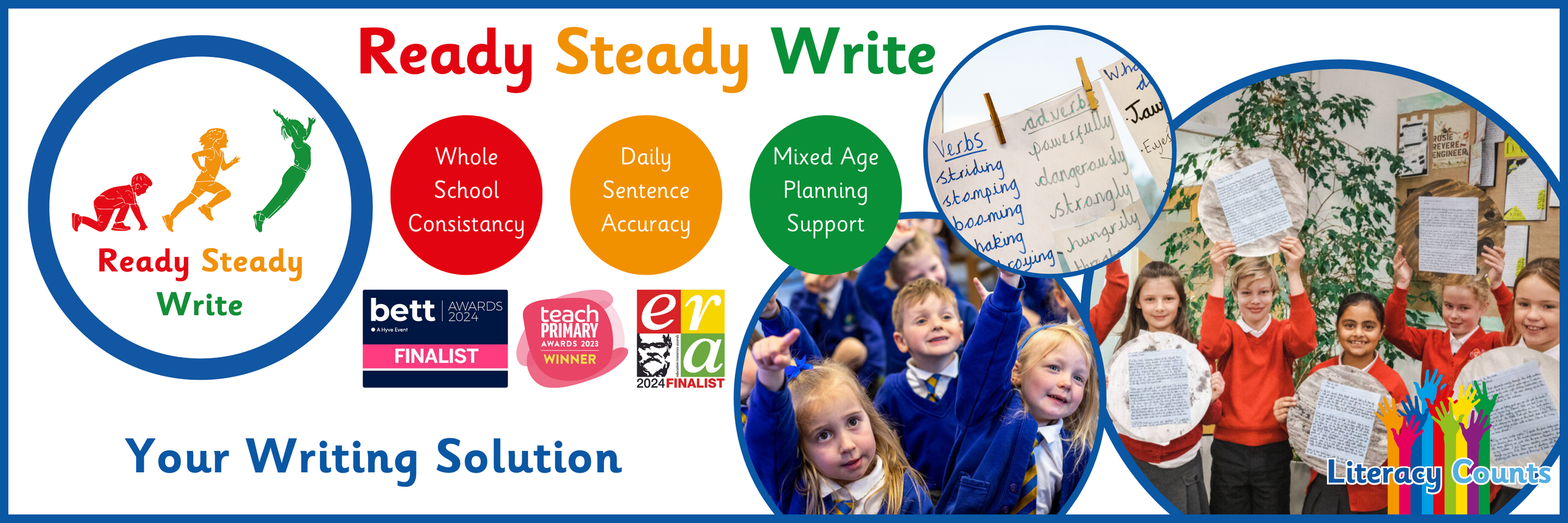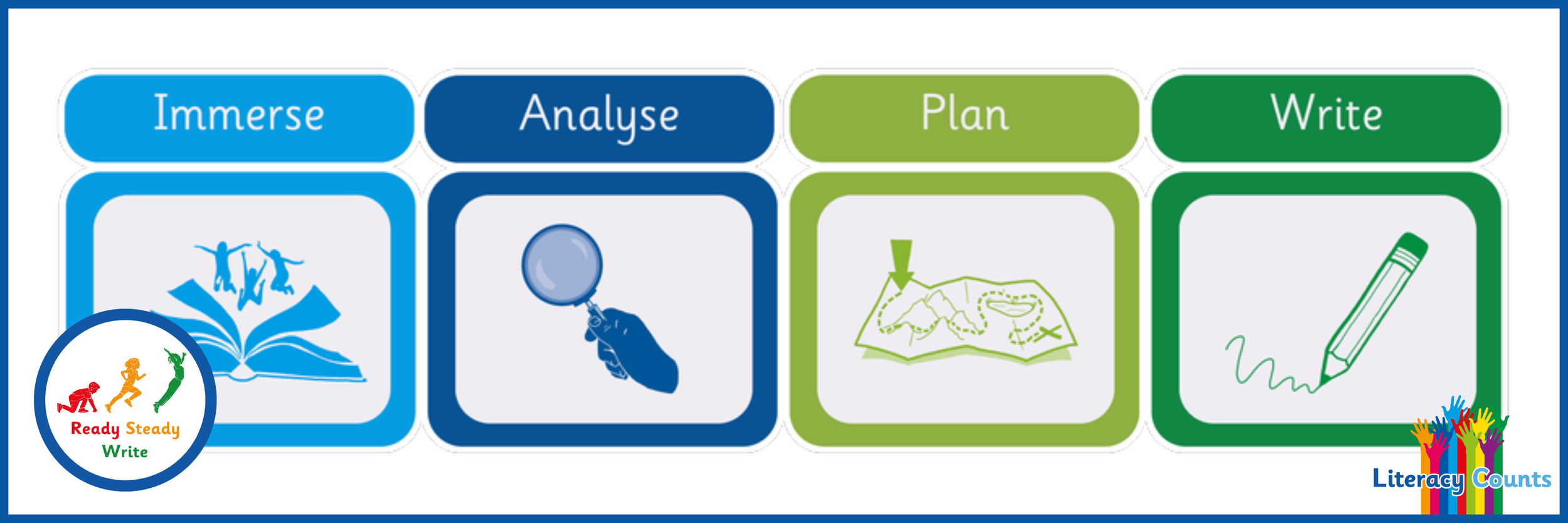Research Influences - Ready Steady Write
Ready Steady Write is an online resource with everything teachers and leaders need to implement a dynamic, sequenced, and ambitious writing curriculum. All available at the click of a button!
Writing is a complex process. And because it is difficult, we are committed to creating resources for schools that draw on a wide range of evidence about what works. This comes from academic research, the privilege of working with and learning from national organisations, and of course our work with many inspirational teachers and schools.
Our Ready Steady Write resources follow a common sequence: Immerse, Analyse, Plan and Write. This is based on a tried and tested model (UKLA and Primary National Strategy, 2004 p.7) and acknowledges the strong interrelationship between speaking and listening, reading and writing.
All of these Ready Steady Write resources include reading for pleasure: there is clear evidence that children learn to write from what they read (Barrs and Cork, 2002). Our Vehicle Texts (children’s language-rich picture books) are carefully chosen to be read aloud, enjoyed and discussed. They are challenging and beautifully written, and also provide important opportunities to teach new vocabulary explicitly (Beck et al, 2002). The illustrations lend themselves to Booktalk (Chambers, 1999) and drama (Heathcote and Bolton, 1994 Taylor, 2016) and also provide rich and engaging opportunities to write for a genuine purpose to a range of audiences which can be highly motivating (EEF, 2020).
If children are to write at greater depth, they need to know what excellence at that exact standard looks like (Clarke, 2020). So, alongside the Vehicle Texts is an additional piece of writing that we have called an Example Text. You may know this as a WAGOLL (what a good one looks like) and it has been carefully crafted to provide one example of what the outcome might look like at greater depth. This isn’t designed to be learnt by heart or replicated. We have designed it for attentive reading and finding out how writing works (Andrews 2008). Experienced writers can draw on a ‘repertoire of possibilities’ (Myhill, 2012) and the Example Text allows discussion about the choices the author has made and the effect on the reader. We suggest activities to make the generic structure, its language features, and knowledge for the writer visible (DFES, 2008) under the heading Writer’s Knowledge. This explicit teaching is an important way of improving writing (EEF, 2020).
Both the Vehicle Text and Example Text provide opportunities to explore and practise ways of controlling grammar for effect. Grammar skills are best learned in the context of purposeful writing (Grammar for Writing DFEE 2000). We include grammar activities that can be augmented by other resources as needed. Teaching Grammar Effectively at KS1 (Bearne, Kennedy and Reedy) is an excellent text.
The Ready Steady Write resources include many opportunities for modelling and helping to shape the voice children can use themselves when they are writing independently (EEF, 2017). This powerful pedagogy is crucial to being an effective teacher of writing. Creating your own Example Text can be challenging, so there are examples that you can use. Successful independent writing is the end aim of all this preparation. The one box per paragraph planning frameworks (Grammar for Writing DFEE 2000) are provided to support this, as are suggestions for supporting the writing process (Smith (1982) and Graves (1983), included to help children regularly loop back on their writing and begin to assess its quality and likely impact.
Finally, we have planned the Ready Steady Write resources to be enjoyable for you as teachers too – particularly the evocative picture books we have selected. We will continue to shape and develop them in the light of new research and understandings, and very much welcome your feedback.
Literacy Counts References
Andrews, R. (2008) The case for a National Writing Project for teachers, Reading: Centre for British Teachers (CfBT) Educational Trust.
Andrews, R. (2008) Shifting Writing Practice: focusing on the productive skills to improve quality and standards in Getting Going: generating, shaping and developing ideas in writing Department for Children, Schools and Families, 4–21Crown Copyright.
Barrs, M. and Cork, V, (2002) The Reader in the Writer. CLPE, London.
Bearne, E., Kennedy, R. and Reedy, D. (2016) Teaching Grammar Effectively at KS1.
UKLA, Leicester. Beck et al, (2002) Bringing Words to Life Guildford Press, London, NY.
Chambers, A. (2012). Tell Me: children, reading and talk. Thimble Press, Stroud.
Clarke, S. (2020). Formative Assessment: a summary. Available from: https://www.shirleyclarkeeducation.org/what-is-formative-assessment/
DfES, (2008) Support for Writing National Strategies, London.
EEF, (2017) Improving Literacy in Key Stage 2 Guidance Report. EEF, London.
EEF, (2020) Improving Literacy in Key Stage 1 Guidance Report. EEF, London.
Graves, D (1983) Writing: teachers and children at work Portsmouth: NH Heinemann.
Heathcote, D. & Bolton, G (1995) Drama for Learning.
Myhill, D., Lines. H. and Watson, A (2012) Making meaning with grammar: A repertoire of possibilities mETAphor 2: 1-10.
Smith, F (1982) Writing and the Writer. London: Heinemann. Taylor, T (2016) Mantle of the Expert Singular Publishing. UKLA, (2004) Raising Boys’ Achievements in Writing. UKLA, Leicester





